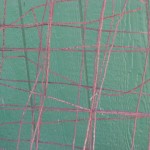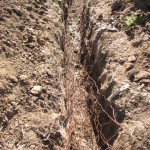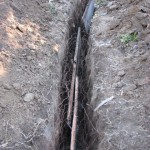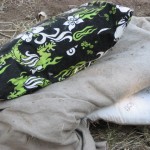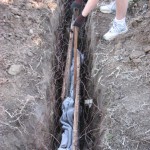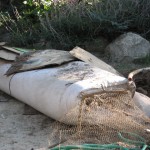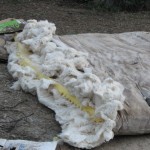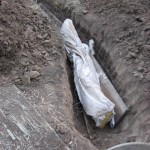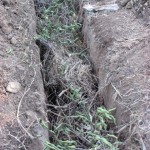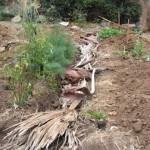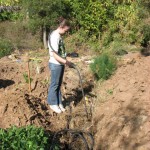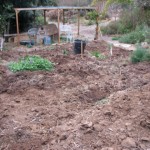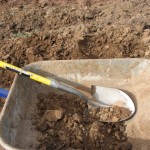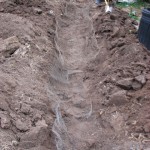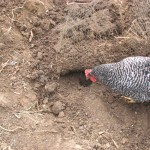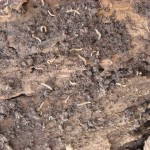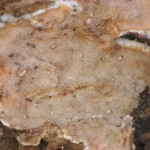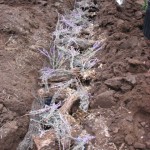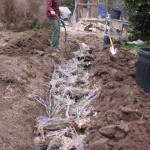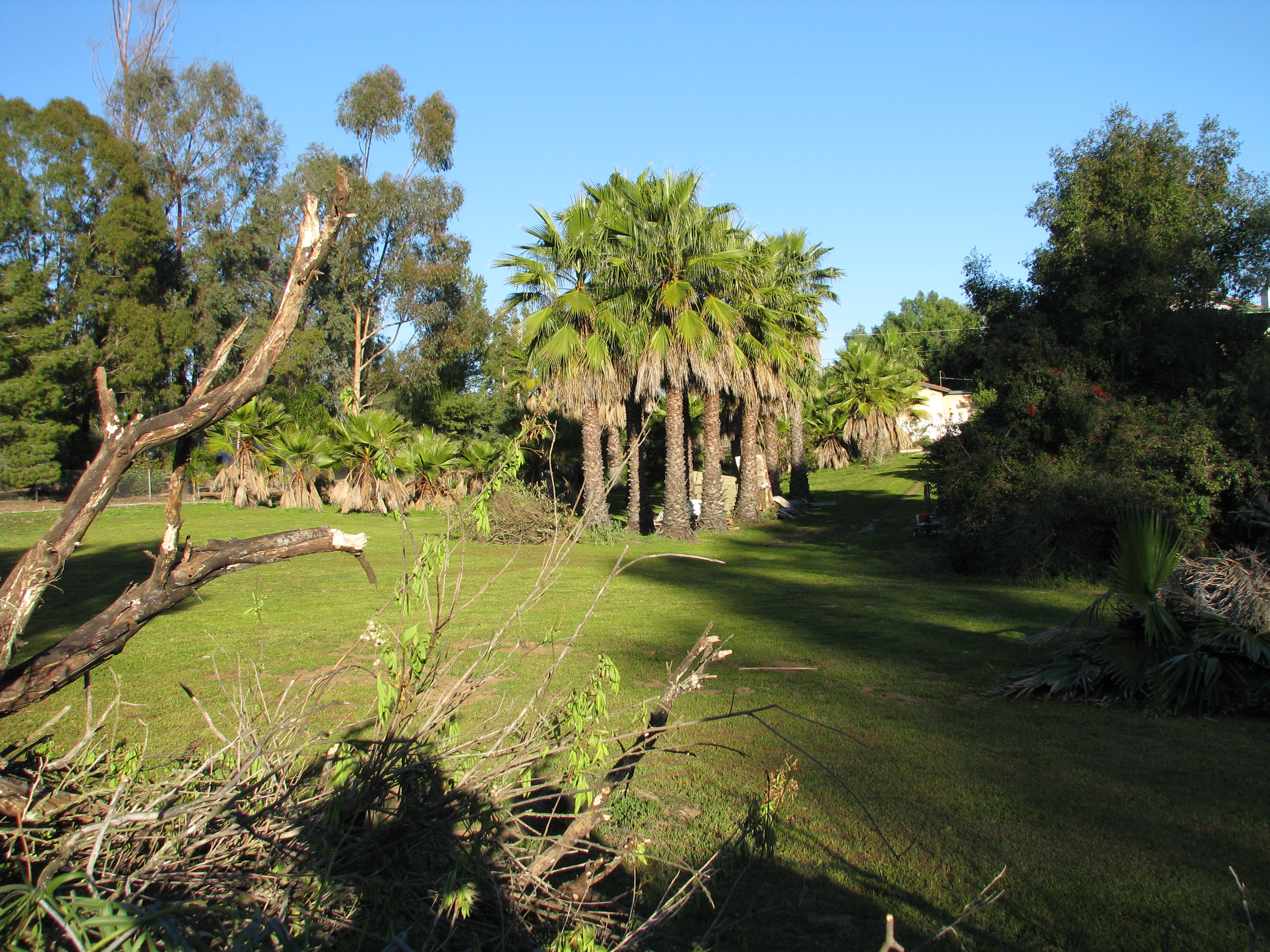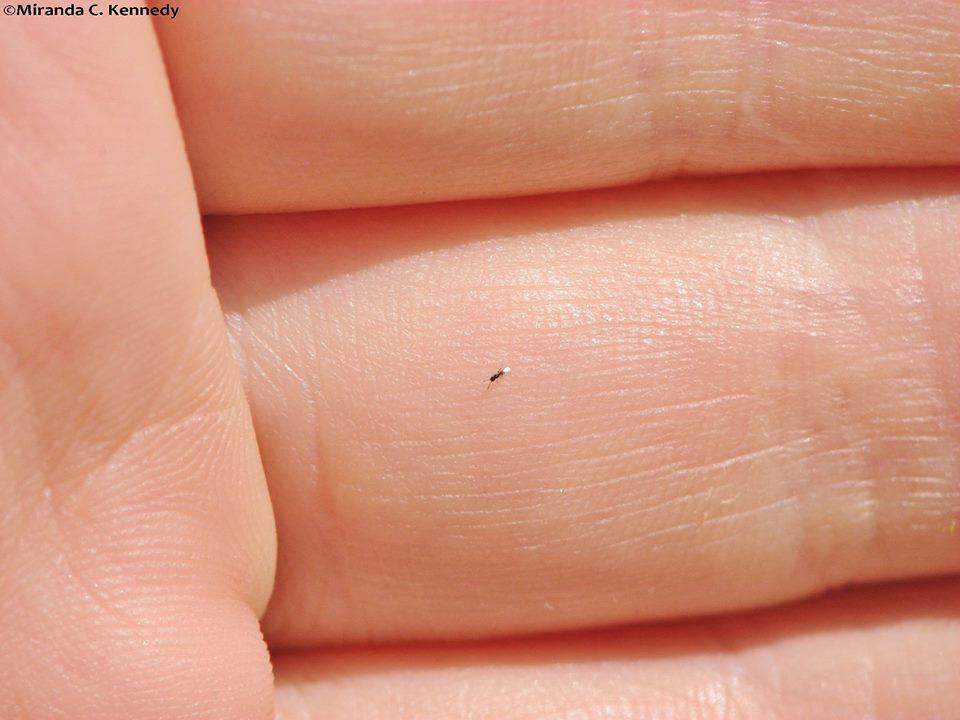- Compost, Gardening adventures, Hugelkultur, Other Insects, Permaculture and Edible Forest Gardening Adventures, Pets, Rain Catching, Soil, Worms
The Sunken Bed Project, Part Two
Old wire can be buried! Remember the trenches? We lined the trenches with old rusty wire, to rot, add iron to the soil, and discourage rodents. Mostly just to get rid of it. Inside the wire we lay old wood; in this case, the half-rotten sides of the old raised beds, nails and all. Fabric can be buried, too! Pet bedding no longer fit for man nor beast. Except for microbes of course. Around the wood we packed old fabric, most of which had been dog or cat bedding after long use in the house. There was also this futon! It had been a bed for years, and then it was the bed for the dogs for years. And for some mice. It took a little cutting and pulling to separate the cotton batting and the foam. Although the foam isn’t made from a natural material, it will eventually rot, but meanwhile will function like a ginourmous buried sponge for rainwater! The futon slices layed in the trench. Yipee! The stinky old futon is gone! Lots of branches, twigs, and woody materials were added, as was some year-old humanure, urea, and fallen limes. Nasty prickly lime tree branches, too. Serves them right for scratching me! After layering the trench materials with soil I used palm fronds for the top organic layer. Every step was watered in. Our 700-gallon water tank, formerly an organic fertilizer tank which Jacob managed to have donated, catches some of the roof rainwater. It has more than enough to water in this project, and then if it ever rains again the tank will be empty and ready for fresh water. The trenches filled in. Futons, scrap wood, woody bits, old stinky fabrics, manure… its all buried and ready to turn the clay into a microbial wonderland. We hauled chunks of extra clay up the hill and staged it by the upper pond, which needs to be resealed. Good leg exercise. The long hugelkultur strawberry bed was above ground, so it had to be reworked. We dug out the wood, wrestled out the wire, dug down about a food then lay the wire back down. There were gopher tunnels under the wire where they had come up and smashed their little noses against the wire. The wood that had been buried for a year was full of life! There were many very cool fungi. Tiny centipede-type decomposers eating away at the wood, all of which had been underground. More great fungus. On top of the wire went some more old textiles, then most of the old wood. Bunches of herbs that had been gathered for wreathes and not used were tucked in around the wood. Worms love thin woody stuff. Pigeon guano, thanks to our neighbor who delivers, was sprinkled over it all. Everything was well watered with rainwater, and then covered up. Next time: design, replanting asparagus, and perhaps even the final product! - Compost, Gardening adventures, Hugelkultur, Permaculture and Edible Forest Gardening Adventures, Rain Catching, Soil, Vegetables, Water Saving
The Pros and Cons of Raised Beds
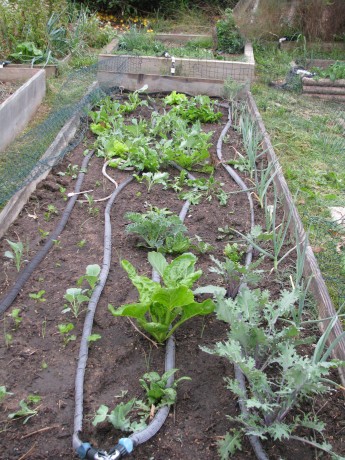
The raised beds. Raised garden beds can be wonderful things. They also can be inappropriate. I’m in the process of taking ours down and replacing them with… well, I’ll describe it later on. Let’s get back to the pros and cons of raised beds.
Here are some of the pros:
Raised beds look just great. They are neat, tidy, organized and restful to the eye.
If raised high enough they are accessible to those who can’t work on the ground or bend over, and to those who are non-ambulatory.
If lined with hardware cloth they keep gophers and mice from tunneling under your food and making it magically disappear.
They help with some weed control.
If you live in a rainy area, they help with drainage.
If you have miserable soil, you can garden anywhere by building a raised bed without having to dig.
If you live in a cold area, depending upon what materials you use for the sides of the raised beds you can tap into the thermal heat and have warmer soil longer.
You can build reusable covers for the beds and turn them into cold frames, or shade structures.
Now here are some of the cons:
You need to fill raised beds with a lot of soil, and if you have to buy it, that is a large expense. The soil will compact and disappear over the course of a year, so you have to keep topping up the beds to keep the soil level high. Heavy work that is expensive.
Wire underneath the raised beds will last a few years and then will be compromised by rodents, so the bed will have to be emptied and rewired if rodents are a problem.
If you live in a warm, dry climate, the sides of the raised bed acts like a clay pot. It will wick moisture from the dirt and heat the dirt up so that plant roots around the perimeter will cook.
If you live in a warm climate you have to pour on the water because of the point mentioned above; a raised bed dries out much more quickly than in-ground gardens.
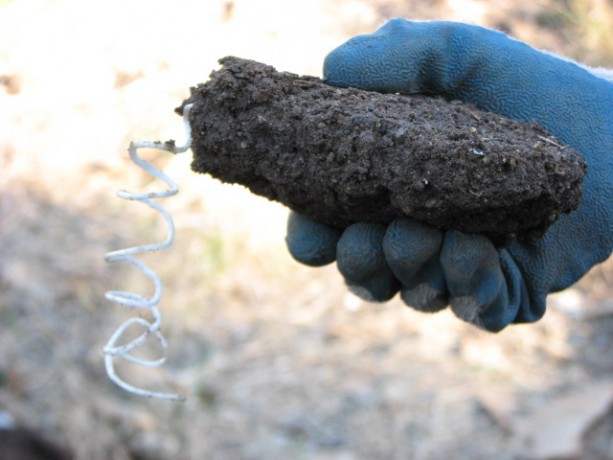
We are wealthy in clay. A Bermuda grass root hangs like a piglet’s tail from this clump. I built raised beds from old bookshelves many years ago, and that was my only veggie garden on the property as I raised my children. I’d grown plants in-ground before that, trenching and turning, and losing the fight against gophers and Bermuda grass. The raised beds were lined with wire. For awhile it worked, but the Bermuda grass took over and infiltrated all the beds. The wire began to rot and rodents chewed away at the sweet potatoes. Worst of all, the soil level would decrease, and since the beds weren’t very deep, then root veggies would grow into the wire and I’d lose half of them as they broke off during the harvest. I couldn’t keep up with refilling the beds. I composted in place, buried wood and vines, and that worked well, but I still needed to add compost. The beds drank up water during our long, hot summers.
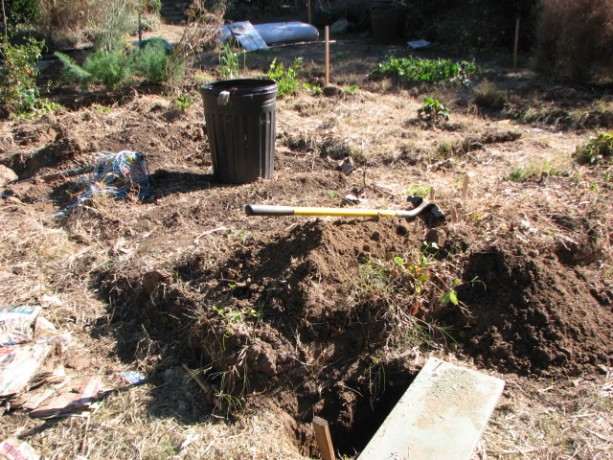
The trenching begins. This summer I realized that I was using a gardening technique that was best suited to rainy climates. Here in the dry Southwest, a traditional gardening method was to plant in sunken beds. We need to capture water, not make it run off. Also, the Bermuda grass became so invasive that I realized that only sheet mulching would make any difference in controlling it.
Of course I decided that my daughter and I couldn’t possibly have an easy winter, but must rip out the beds and start digging.
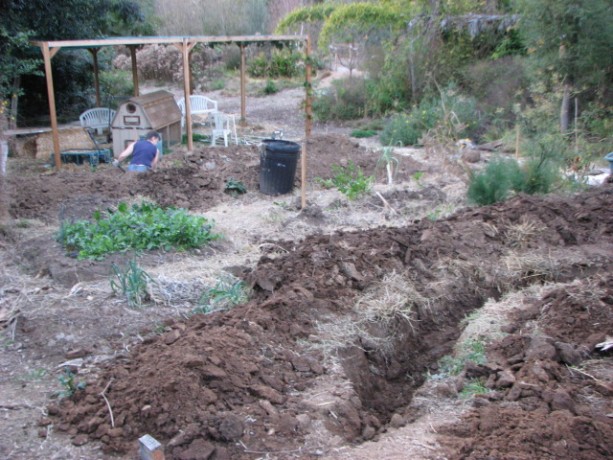
In the trenches. I’m an advocate of no-dig gardening; however sometimes you have to dig bad soil to create good soil. The no-dig policy can happen once the infrastructure is in place. So here’s what I’m planning on doing: I’m combining hugelkultur with sunken gardens and sheet mulching to create what I hope will be a veggie garden with a much lower water consumption, and weed-free.
First we determined the direction of water flow down the hill, and planned on creating trenches that would capture that water. The trenches, or swales, would need to be level on the bottom so that any water flowing in from the downhill side, would travel all along the swale even to the drier side, where the surface soil was higher. We created a bunyip to estimate the difference in slope between the top and bottom of the garden. Although I had drawn up intricate plans for a square garden, that shape just wouldn’t work so we went with a rectangle. Then we began to dig. The first ten inches wasn’t bad, but after that we hit clay. I had to buy a mattock. I also ended up icing my back for a couple of days. Some of the clay we’ll save for use on any future earthworks we may want to do, and some we’re saving for an artist friend.
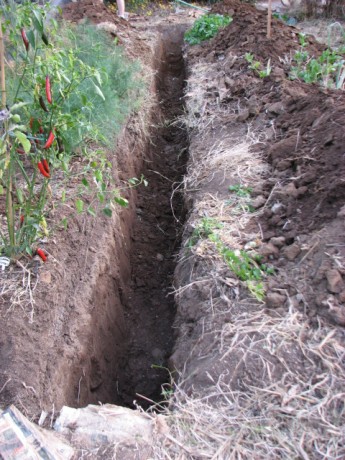
The soil was good for about ten inches, then we hit clay. The trenches are two feet deep, and about one to one and a half feet wide. It is amazing how you start out large, and then after a few very hot afternoons scraping clay and throwing it up and over four feet, the trenches become more narrow. My plan is to fill the bottom foot of the trenches with old wire, wood, branches, old textiles and other biodegradable debris. The old wire will rot, and will also help repel gophers. On top of all this will be layered some of the clay, and watered in with compost tea brewed in the 700-gallon water tank that is full of rainwater from the last rain (two months ago!). On top of that will be good soil, smoothed below the surrounding surface level. Water from the road will be diverted into the swales, which will allow it to flow across the garden and be absorbed by the fill materials. But what about the Bermuda grass? There isn’t a mountain of cardboard all over my garage for nothing! The entire garden will be sheet mulched, and all veggies will be planted through the cardboard and newspaper. The existing asparagus bed will need to be carefully relocated, but everything else can either be harvested or dug under.
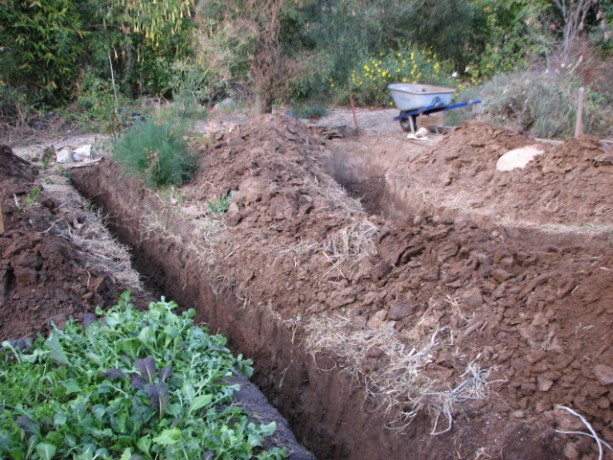
These first two trenches will collect rainwater from the pathways and channel it the length of the garden. That’s the plan, anyhow. I’ll let you know how it goes.
- Arts and Crafts, Gardening adventures, Humor, Permaculture and Edible Forest Gardening Adventures, Water Saving
Remodeling the Outdoor Sink
I’m thrilled with my outdoor sink. I love it. It is my friend. It is my old kitchen sink, stubbornly hauled around the property until I finally was able to put it on an old fishtank stand and hook it into the waterline out in the garden. Even better, Steve, who used to work here and who was responsible for the Mock Pavilion, modified the stand so that the sink fit down into it more securely. Any water used would be caught in buckets underneath (with long sticks in them so that any creature that falls in can crawl out again), which I would pull out and empty.
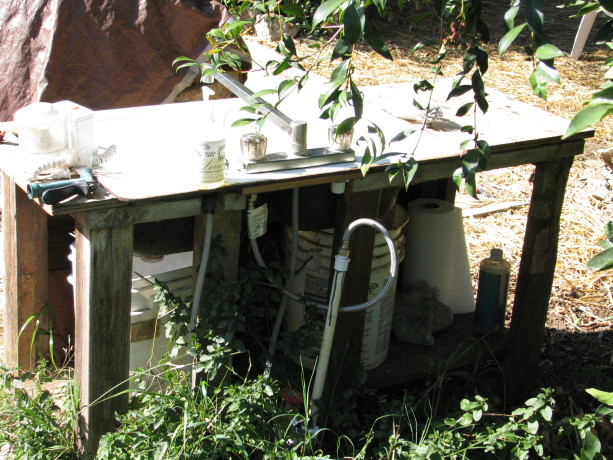
The buckets are just another heavy thing with which I had to deal. There had to be another way. A problem with the sink being set down into the stand is that the underside of one of the drains now sat slightly into a bucket, so I’d have to tip the bucket to get it out. Wrestle it out would be the better term, usually becoming wet with old sink water in the process. Throwing a 5-gallon bucket of water somewhere lost its charm quickly, especially as I was the only one emptying, but not the only one filling. Something had to be done. When I made the area next to the Fowl Fortress into an apple tree guild, I now had an area which could use extra water. The sink needed to be moved. Last week I finally did it, and I have to say, I’m pretty smug about how.
I am a disaster with a saw, but I’m pretty experienced with old PVC pipe and Red Hot Blue Glue (all those sprinklers I’ve mowed down over the years). I leveled a place next to the coop and placed some old plywood on it, both to help steady the sink stand and to keep weeds down (and to use up the plywood).
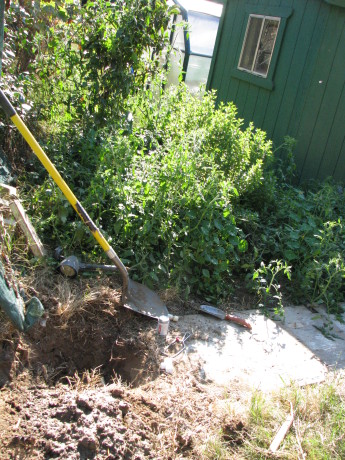
I dug up the water line and placed plywood on a leveled area. I dug up the water line, turned off the irrigation water, opened other faucets to drain and then cut into the pipe. Then I discovered the real pipe beneath this old dry one, and dug it out and cut into it, allowing it to drain as well before connecting a tee.
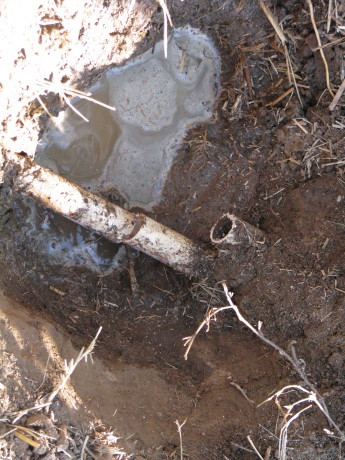
Beneath the old pipe was the real one. The hens were all pressed against the side of the coop trying to see what I was doing, and desperately wanting to search for bugs in the dirt I’d just dug up. Sorry girls.
I laborously walked the rather heavy and unevenly weighted stand (the sink isn’t in the center) over to the plywood. Then I walked it off again, adjusted, and walked it back. Then I adjusted again. Then I had a sit-down and wondered what my chiropractor was going to say.
Now came the fun problem-solving part. The drains from the sink were open, so how to catch water and send it off into the guild, without spending a bunch of money? The vision came to me from out of the blue: plungers. Some people have visions of how to earn lots of money, others have visions of how to change the world for the better. My imagination provides me with plungers. Yep.
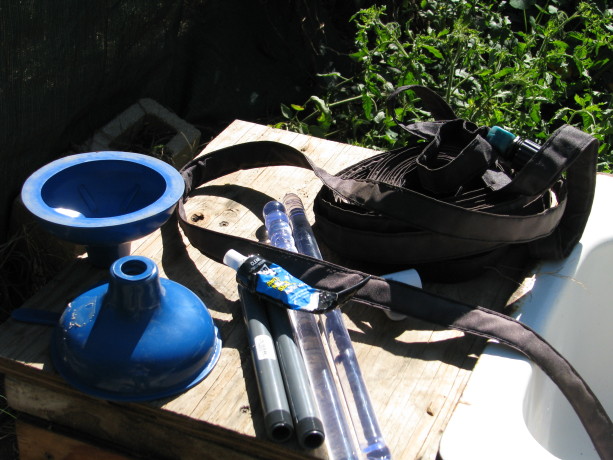
Supplies. I learned from my collegiate daughter, and the hardware store cashier, that plungers were nicknamed ‘magic wands’. No matter how much I learn each day, I’m always in the dark on the important things. However, I felt pretty proud of myself and was excited to get started. I rooted through my barrel of old PVC left from the former owners (I’ve lived here over 14 years and the PVC was already old then) and through my fittings. I only needed a couple new fittings and the plungers from Joe’s Hardware. The plungers had blue cups and clear handles, not the wooden-handled, black-cupped manly plungers of my imagination. If wizards had plungers, I could see them using these. Well this would be a female version and blue is my favorite color.
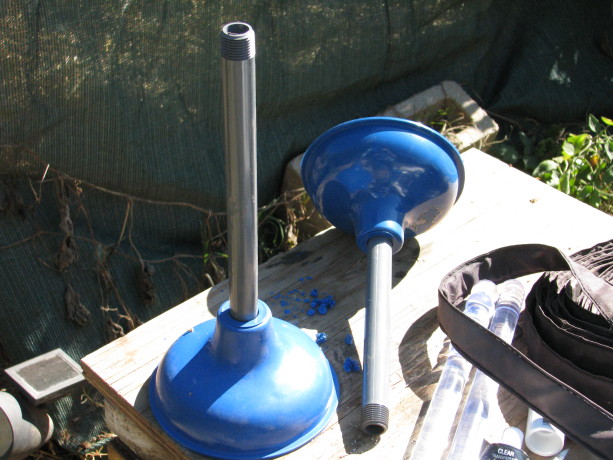
I screwed in threaded 1/2″ risers and tried them as is, but they leaked, so I put silicone gel around the threads and tried again. It worked after the gel dried. Knowing that the thread of the plunger handle wasn’t the same thread as a PVC riser (how do I know these things? Am I channeling some long-dead plumber??) I grabbed silicone sealant I had recently purchased to seal up leaks in a small fountain so that it would work during garden tours (the sealant worked, but then the motor failed. Sigh.)
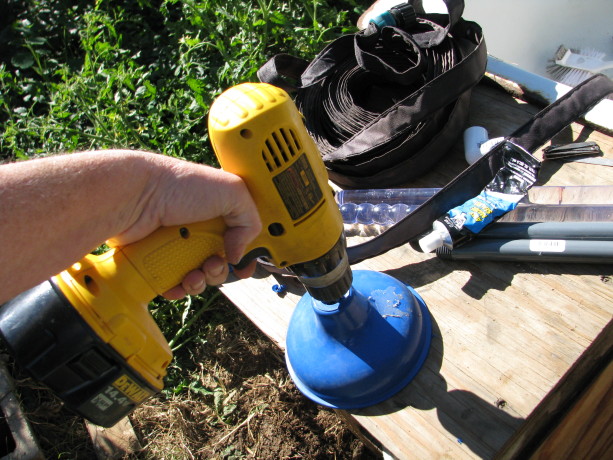
Drilling drain holes in the plunger cups. I had expected to find plunger heads and handles sold seperately, and remembered seeing plungers with threaded holes all the way through. I must have been flashing back to the cheap supplies offered to the parks department when I was a Ranger because all I found at Joes were complete, and the holes were covered (better suction). I drilled through the rubber to make the drain hole (which created some very cute blue rubber curls).
I connected up most parts, but then came the challenge, to space the plungers the correct distance apart, and measuring is not my thing. It seems simple, but it never works for me. My ginko must have kicked in, though, because I realized that I could just place the plungers over the sink holes on top and build it up there, and of course it would be the correct distance underneath.
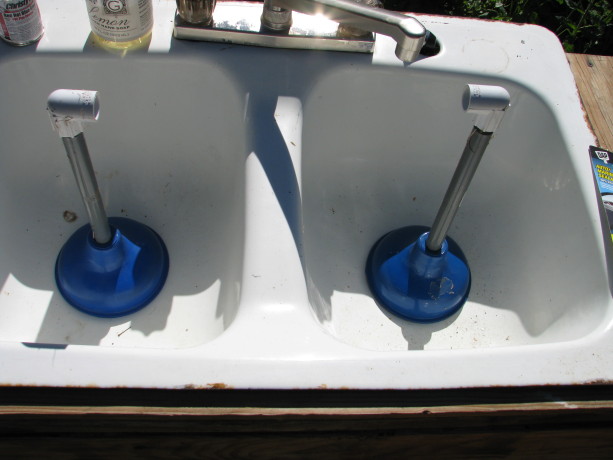
Ha! I didn’t have to lay in the tomatoes and work around the legs in the back! I could do it on top and still get the length right. I’m still proud of figuring that out.
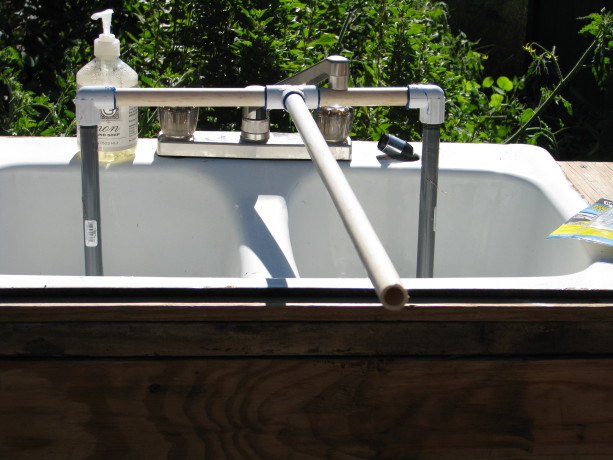
All ready to go. The trick really was to get this thing in place around the support legs behind the fishtank stand! 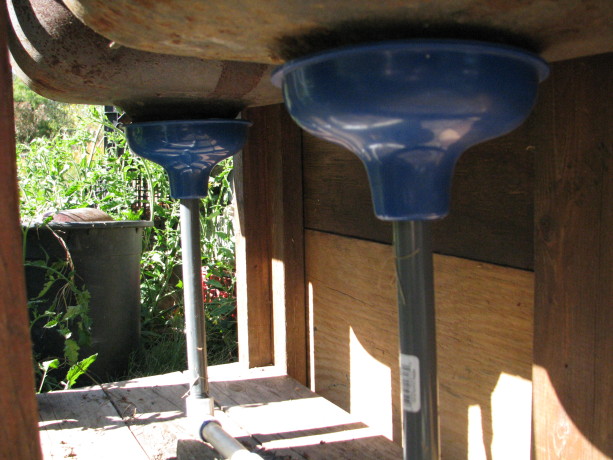
My beauties. My plan was to screw it into a soaker hose that I already had, but I worried that without water pressure it wouldn’t work. It didn’t.
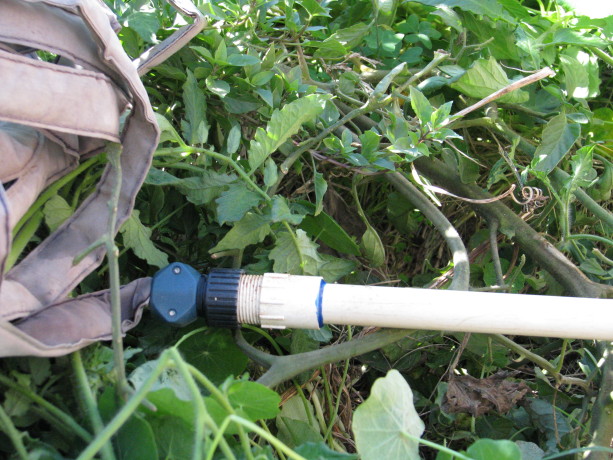
The soaker hose idea failed because of the lack of water pressure, and caused the water to back up and overflow the plunger cups. I removed the screw end from the PVC and glued on more 1/2″ pipe so that the water would directly empty near the apple tree.
There were a few other tweaks, such as widening the drill holes in the plunger for better water drainage, propping the pipe up on a piece of wood so that it fit the drains more securely (it isn’t fastened onto the stand so that if I had to access the plunger cups I could do so easily), and placing screen over the drains so no one would lose a ring down into the device.
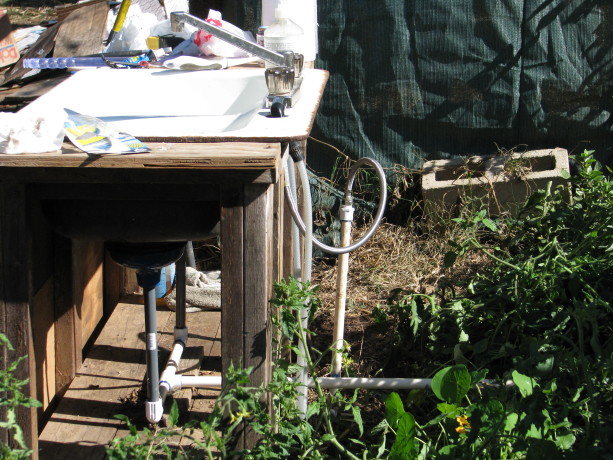
Now the water drains directly into the bed. Tip: glue the long pieces on once the main part is in place under the sink. Plants will grow up around the back of the sink to hide it from view. Now it all works, I have less work to do, no yucky buckets to haul, the apple tree receives greywater, I repurposed several items and although I had to buy a few things, I supported a local business, the sink is in a better location, and I like the blue color of the plunger cups.
Best of all, now I have some snazzy clear handles to use for some other project!
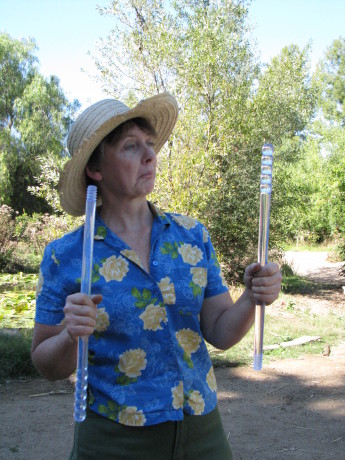
Hmm. Threaded magic wands! I wonder how I can repurpose these beauties?! - Animals, Gardening adventures, Hugelkultur, Natives, Other Insects, Permaculture and Edible Forest Gardening Adventures, Ponds
Then and Now
This photo was taken just as work was begun on transforming the property into a garden, in February, 2011.
This photo was taken last Thursday, Oct. 31, 2013, from the same location.
This view may look weedy, especially in the early morning light on this brilliant Halloween morning. What you are seeing is the first bog, which is the green spot in the foreground. The dirt area is the overflow, if torrential rains ever come again. To the left, the tall bushes constitute the withy hide, and to the left is the big pond, although you have to take my word for it. Tall bamboo arches over the stumps of the palm trees in the above photo, which are trellises for roses and other vines. A nectarine branch is in the right foreground. The tall flowering plants are a native called fleabane. They reseed readily, and I allow them to because of several reasons. They grow five to six feet tall and help shade smaller trees and plants against the harsh summer sun, protecting them from sun scald. They also die off in the winter, making good hugelkultur material. The purple flowers, which are in the above photo now turning into fuzzy seed clumps, are attractive. The most important thing though is that they are excellent hosts for native insects of all kinds. Ladybugs, lacewings, spiders, and hundreds of tiny wasps and flies, many of which are parasitic, all love these flowers. All summer long they are alive with life. Inviting in the native pollinators, and growing a polyculture garden, is the first line of defense in growing naturally.
Allowing nature to define parts of your garden leads to happy surprises and lots of help from unexpected friends, such as bugs, birds and lizards. This kind of garden is endlessly interesting, with new things to study every day.
The following photos were all taken the same brilliant morning, Oct. 31, 2013. Here in San Diego county we were having what is called a Santa Ana, where warm, dry winds from the desert blow westward, as opposed to the more humid eastward flow of air from the ocean that we normally have. Santa Anas can bring heavy winds and make tinder-dry weedy hills a fire hazard, but this year we’ve been lucky and no major fires have happened. We even had almost 3/4 ” of rain, last week, which is practically unheard of for October. The warm Autumn sunshine was intense and lovely, and I had to take photos even though the light was too strong for good ones.
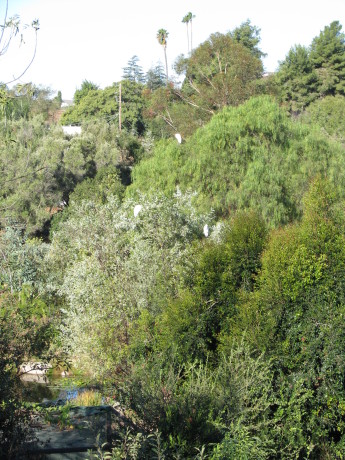
We went up on the roof to view these three greater egrets perched in our trees over the pond. 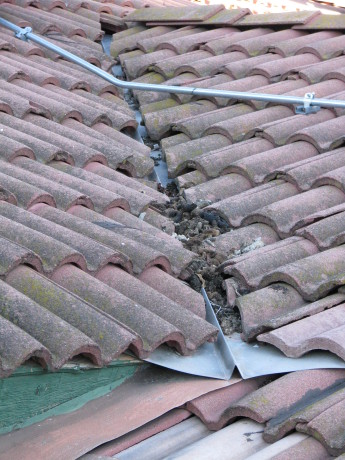
Being on the roof is an education. Here is lots of racoon poo between the tiles. Why?! 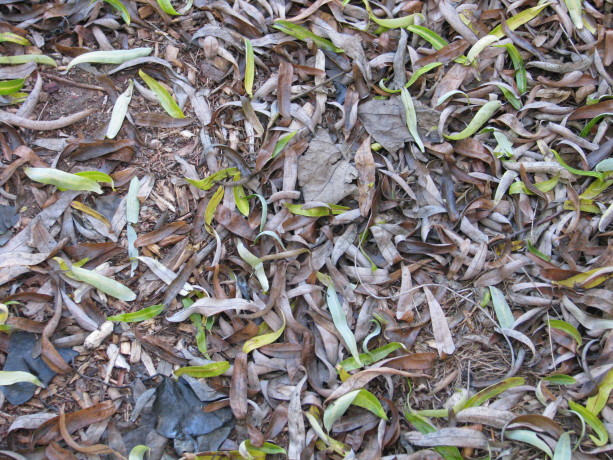
We don’t have dramatic Fall colors here, but the subtle Autumn hues of leaves is lovely. 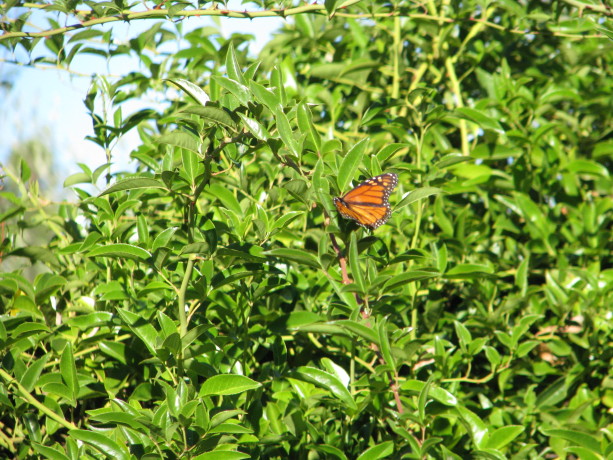
We still have Monarch butterflies. 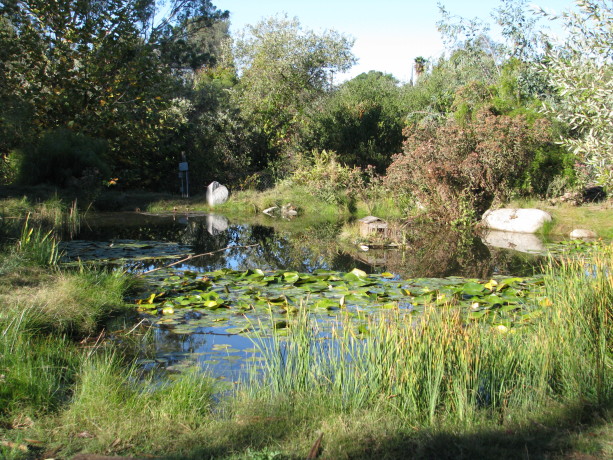
The big pond in early morning light. 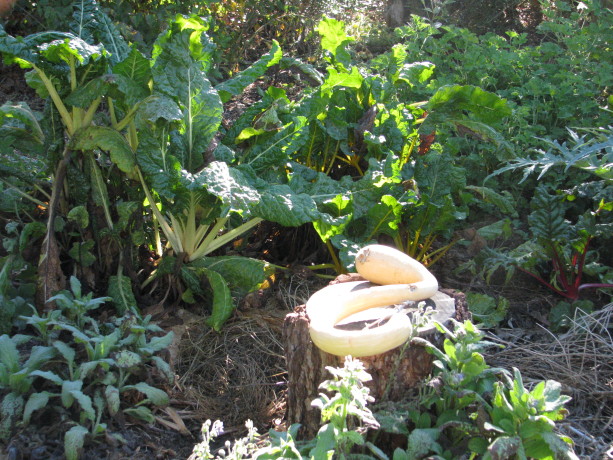
A zuchianno rampicante reclining on a stump. (Its a squash!). 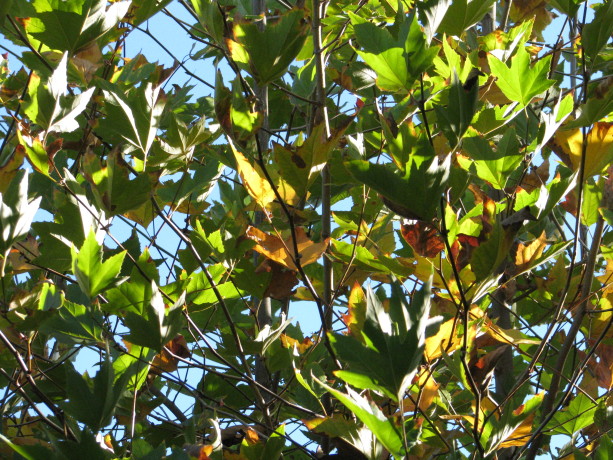
Morning sun through a Fall-leaved sycamore. Beautiful. 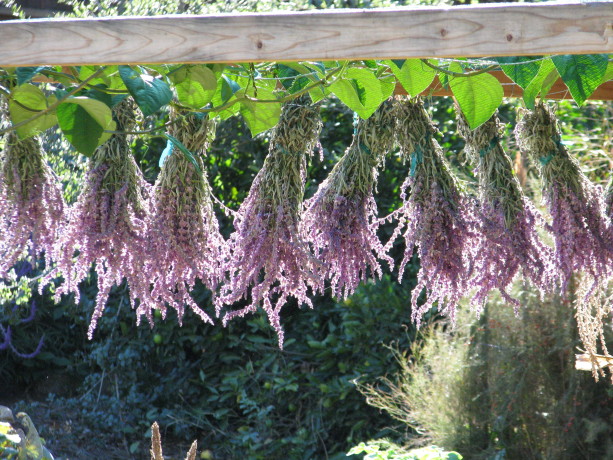
Mexican bush sage hanging up to dry. 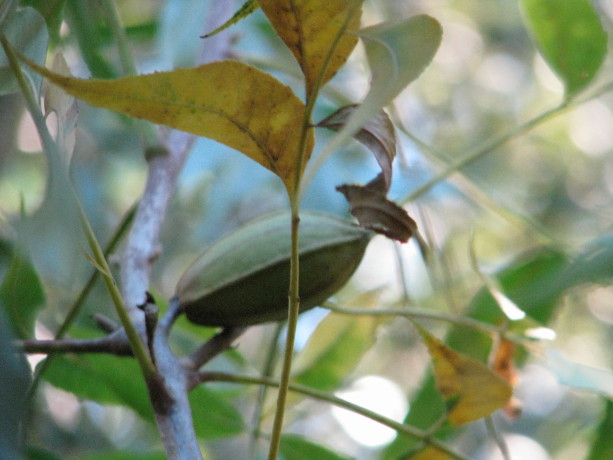
Our little pecan tree put on about six this year! Next year, tons! 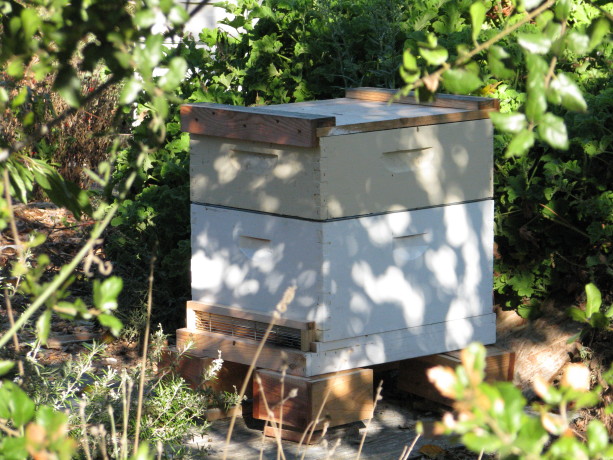
Beehive warming up. 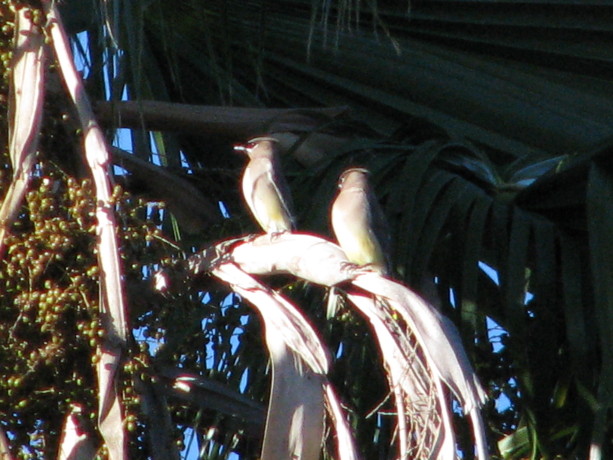
Ceder waxwings (my favorite bird) in the big palm. 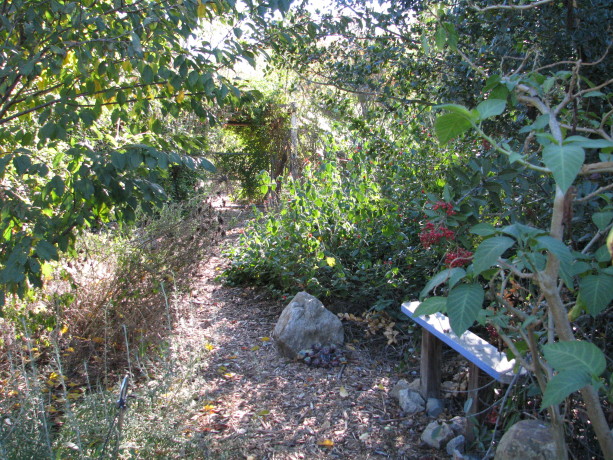
The Bee Garden. 
The liquidambers, also known as sweet gums, are just beginning to turn color. Lots of deciduous trees means lots of leaf mulch, and more warmth reaching the ground during the winter. 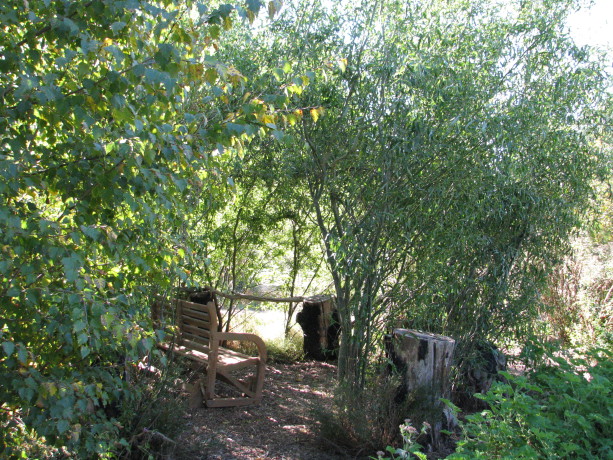
The entrance to the withy hide, with the pond in the distance. 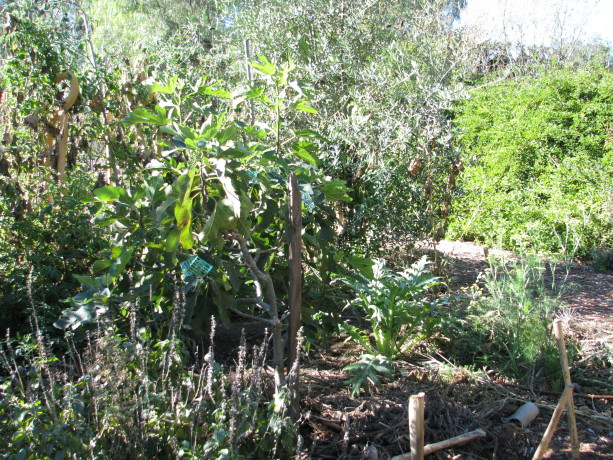
The Mission fig,with artichoke, anise and sage.. 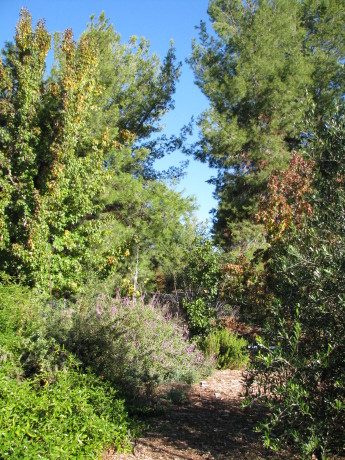
The canopy is growing. 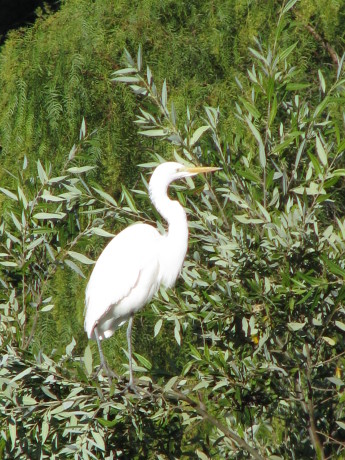
Greater egret enjoying the sun. - Animals, Chickens, Cob, Compost, Composting toilet, Fruit, Gardening adventures, Giving, Grains, Health, Herbs, Houses, Hugelkultur, Humor, Living structures, Natives, Natural cleaners, Permaculture and Edible Forest Gardening Adventures, Ponds, Rain Catching, Recipes, Seeds, Soil, Vegan, Vegetables, Vegetarian, Worms
San Diego Permaculture Convergence, Nov. 9 – 10, 2013
There is a fantastic, information-packed permaculture convergence coming up at the beautiful Sky Mountain Institute in Escondido.
 It will be two days packed with great information for a very reasonable price; in fact, scholarships are available. Check out the website at convergence@sdpermies.com. On that Sunday I’ll be teaching a workshop about why its so important to plant native plants, how to plant them in guilds using fishscale swales and mini-hugelkulturs. Come to the convergence and be inspired!
It will be two days packed with great information for a very reasonable price; in fact, scholarships are available. Check out the website at convergence@sdpermies.com. On that Sunday I’ll be teaching a workshop about why its so important to plant native plants, how to plant them in guilds using fishscale swales and mini-hugelkulturs. Come to the convergence and be inspired! - Gardening adventures, Permaculture and Edible Forest Gardening Adventures, Recipes, Vegan, Vegetables, Vegetarian
Dinner with the Pandas: Harvesting Your Own Bamboo
Hello.
Before you cry, “Imposter!”, let me assure you that I have authorization to be here. Mostly. I happen to be Diane’s daughter Miranda, guestblogging and wordsmithing for you today. You might recognize my powdery feet or recollect me when keeping company with chickens (or from diverse other adventures). As much as I enjoying rolling in dust and home decorating with hens, today I’m here to talk about an unusual topic for Vegetariat – food.
The handy rhyme isn’t the only reason I’m sometimes known as Miranda the Panda – I also have a great partiality for a bit of bamboo, much like the vegetarian carnivore from whom I draw my catchy moniker. Luckily, we happen to have a fair bit of the stuff around Finch Frolic these days (bamboo, not pandas). Bamboo shoots are a common – and delicious! – component of Asian cuisines, and bamboo has been used for many culinary purposes, such as flavoring rice, wherever it grows. During this past summer, I was overcome with the need to find more things to eat on the property and began a foray into harvesting our own bamboo shoots.
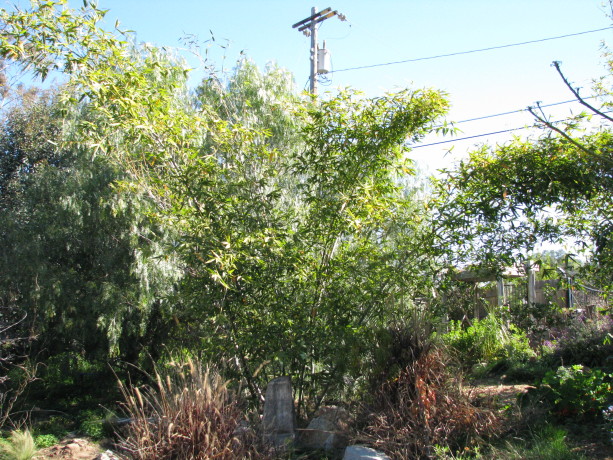
Our giant species of bamboo arches over many of our paths — perfect for building material, and any shoots that venture into the soil of the paths are prime targets… 🙂 Before I stepped outdoors and started gnawing on the nearest clump, I had to be sure that our bamboo is an edible variety, and hopefully a tasty edible variety. You need the scientific name of your bamboo for that, but once we ferreted out ours (Bambusa beecheyana), it was easy to find notation of its edibility and delectability online. One helpful and extensive listing is on Guadua Bamboo. Happily, there is a large number of edible and tasty bamboo species.
Proof of mange-ability in hand, the next obstacle was divining the best way to get bamboo shoots from the ground to my mouth. Harvesting can be more or less of a challenge, depending on what variety of bamboo one has and how it’s established (e.g., moisture and soil conditions, obstacles like stones around it). To harvest shoots, it’s best to pick fat green ones poking no more than a foot above the ground. You want to catch them before they get too woody, but old enough to have a bit of meat on them, so to speak. The shoot is mostly leaf (tightly layered sheaths), so bulkier shoots are more rewarding.
Removing our bamboo from the ground and its parent plant turned out to be on the more side of challenging.
Miranda and Diane bust out the Finch Frolic arsenal on the recalcitrant shoot.
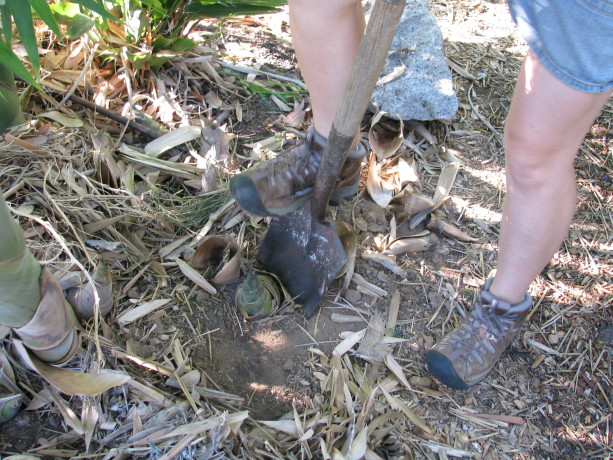
First, the inimitable spade is set to the task. 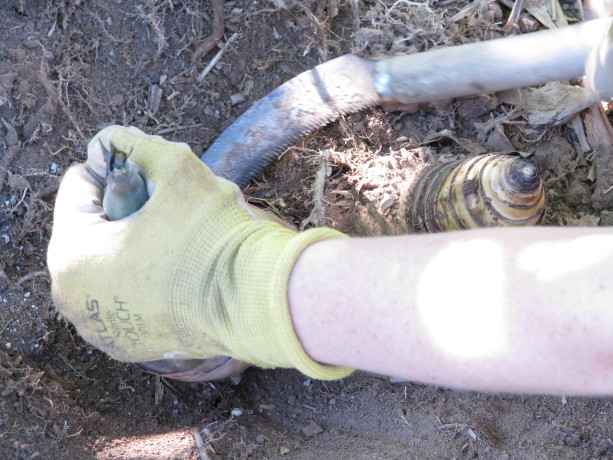
Legs weary and spade abandoned, the small sickle saw is recruited, to little effect. Diane had just returned home and gleefully plunged into the fray, skirt, white sandals and all.
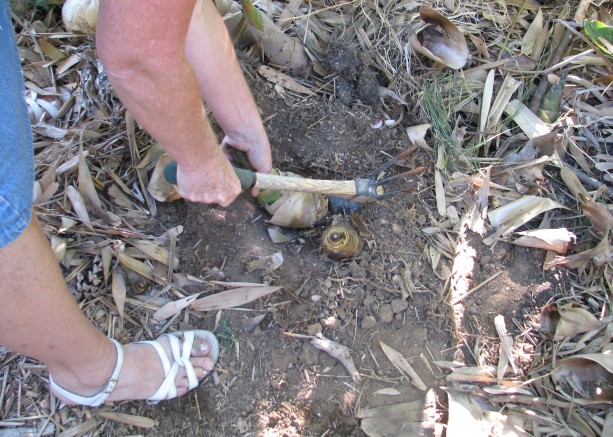
Finally, Diane wades into battle with the winning implement. 
The shoot, freed from the earth and its parent plant. Once we finally achieved success, processing could begin! It is somewhat tiresome to strip a shoot down to the edible white core, because the leaves cling so tightly and are fibrous. It’s like shucking the most stubborn ear of corn in the world. It’s good to slit the tougher outer leaves with a very sharp knife and peel them away.
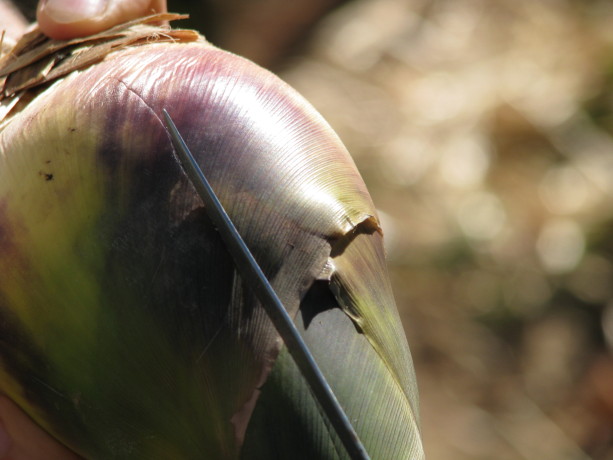
Slitting the fibrous outer leaves with a filet knife. 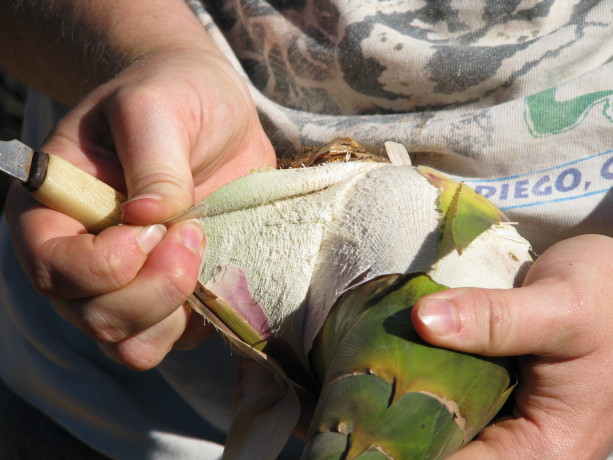
Peeling. The inner leaves come away more easily – rather like the layers of canned hearts-of-palm – as you get closer to the heart of the bamboo shoot. The innermost leaves are basically fetal, and so are edible because they haven’t gotten tough yet. They make the tip of your shoot look hairy.
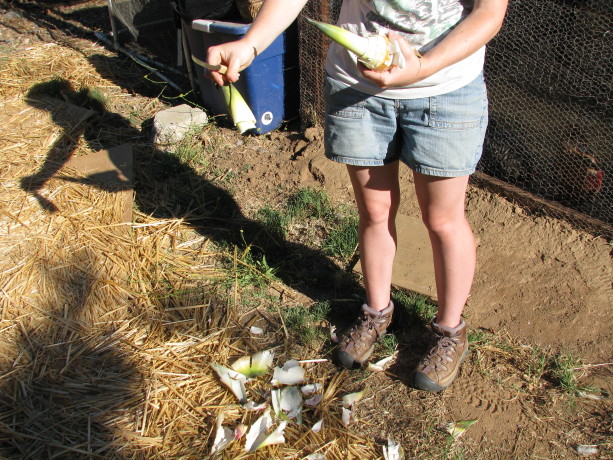
Many layers of increasingly tender leaves. 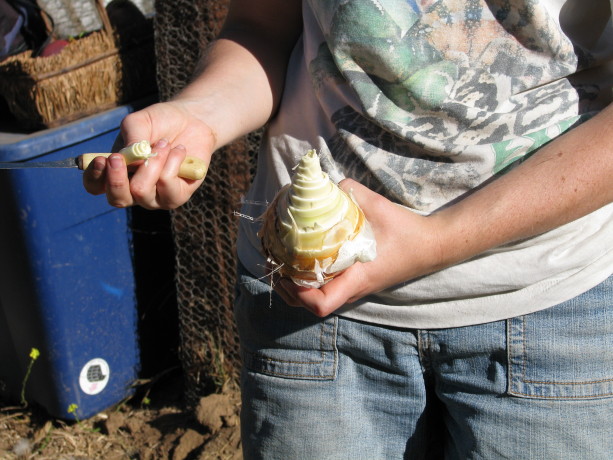
The edible shoot. A peeled bamboo shoot can be cut up in whatever way the chef desires. The shoot grows more fibrous towards the base, where there is probably some inedible hard material. My current rule of thumbs-carefully-tucked-away is if a sharp knife can pretty easily get through it, it’ll be fine to eat.
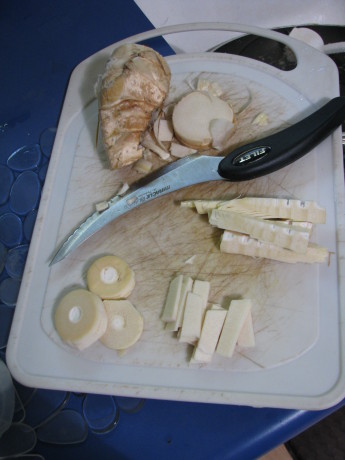
A shoot cut in three different ways. The material behind the knife (upper left) is too fibrous to eat. You just have to boil your slices before cooking and consumption because they contain a mild toxin that dissipates with boiling. The first time, we tried boiling in lightly salted water for only 30 minutes, and while the shoots were tender and not really bitter, they left a teeny tingling sensation in our mouths, like stir-fried Pop Rocks. The last time I cooked them, I boiled them for a whole 50 min. to much more satisfactory, un-tingly results.

Boiling to remove toxins. Bamboo is delicious and a lot of fun (in a somewhat laborious way) to harvest. The beauty of harvesting your own bamboo shoots is that you are saving yourself a trip to specialty markets and controlling your bamboo’s growth at the same time!
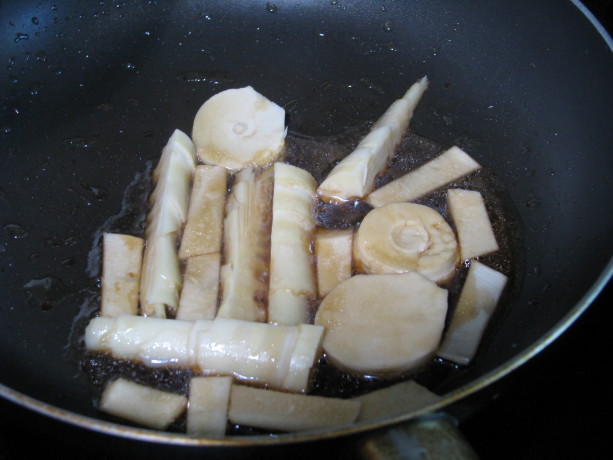
Frying up — yummy! So that’s another thing going on here at FFG. Thanks for wandering the bamboo lane with me.
TTFN!
Miranda (the Panda), B.S.
-
Fruit Tree Guild, Revisited
In June I blogged about how to plant a fruit tree guild, and gave the example of one I was planting by the Fowl Fortress. I thought I’d show you how it matured.

Apple tree in trouble: heavy clay thoroughly shot through with Bermuda grass. Yuck! This was the area four months ago. Heavy, sticky clay taken over with Bermuda grass. A struggling apple tree begs for my help. A star jasmine climbs the side of the Fowl Fortress. A portion of the brown subterranean irrigation system lies aboveground.
Using permaculture design, I created a plant guild with herbs and vegetables that would build the soil and help the apple tree.

A guild is planted. Strawberries went around the trunk of the tree for groundcover and grass competition. Comfrey, a valuable nutrient accumulator in there, too, for slash and drop fertilization. There is also a perennial basil, marjoram, gourds, golden runner bean (a nitrogen fixer), garlic chives, a prostrate rosemary and a tomato, along with other flower seeds. This is how it looks now from the same vantage point:
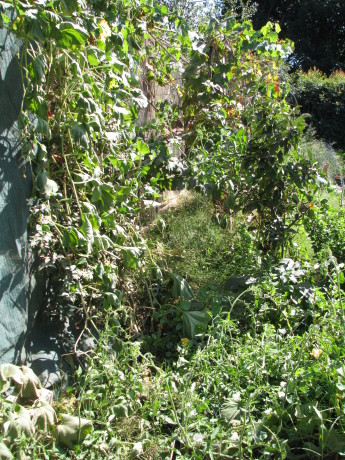
The guild in September. 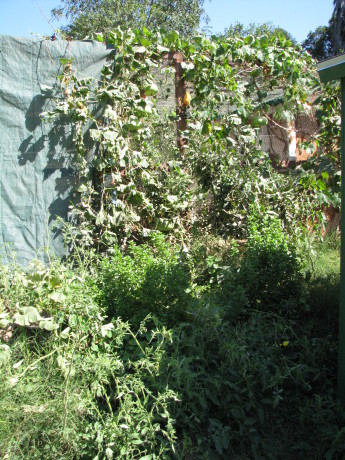
Layers of plants protect the ground and produce food. 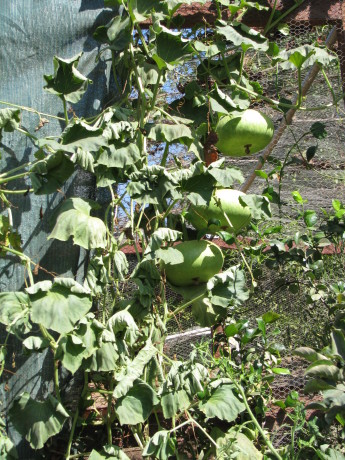
These gourds can be dried and made into bowls. 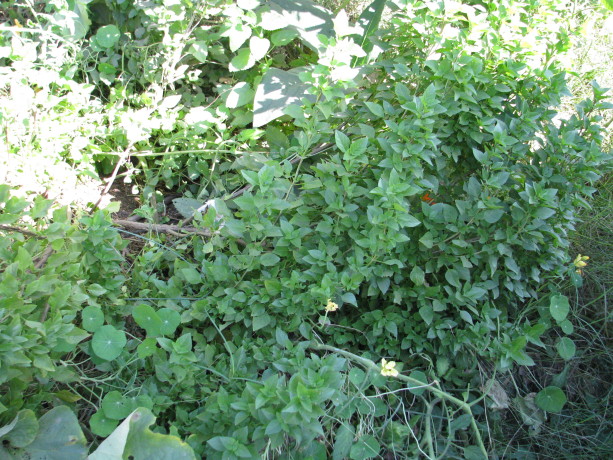
Perennial basil, Amish paste tomatoes smother the weeds and enrich the soil. 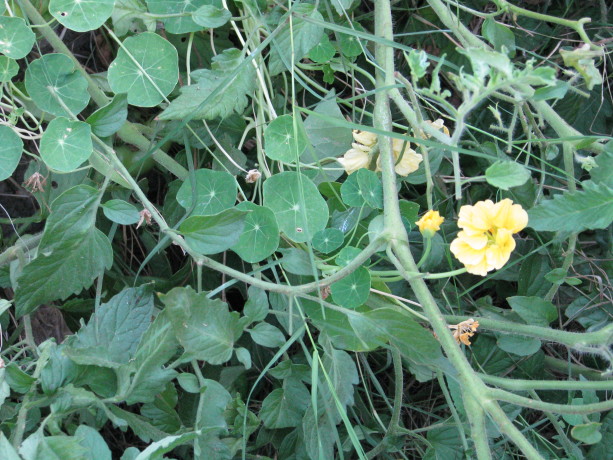
Nasturtiums reseed and fill in as the other vegetables die off. Polyculture beds produce abundant, insect-confusing food guilds which help fertilize and water each other and improve the soil quality. Meanwhile the apple tree has a few apples on it and looks healthier than it has been. Next year’s growth should be drastically improved, and the amount of invasive grasses should be nil. If I don’t grow consecutive annual crops here around the perennial plants, I will sheet mulch the bed.
- Compost, Gardening adventures, Health, Hugelkultur, Other Insects, Permaculture and Edible Forest Gardening Adventures, Soil, Vegetables, Worms
Don’t Clean Up, Dig It In!

Use old vegetables to grow new ones! Tomatoes, eggplant, peppers, fennel, carrots, string beans, three kinds of basil, and probably other things I’ve forgotten about! In January of this year I wrote about Lazy Composting. Frost had killed off sweet potato and tomato vines,
and the soil in the raised garden beds were becoming very low.

- Soil level is very low on the raised beds.
Instead of hauling all the vines to the compost heap or bin, I thought I’d create soil in place. The raised beds are lined with chicken wire to protect veggies from gophers. Although I didn’t want to disturb the microbes and fungus in the soil, I dug out half the beds down to the wire.
Then I layed all those vines right on the soil and covered them up.
Then I did the other half…
- Spent tomato vines, with some green ‘maters still attached.
… and then did the other bed. Any thick stalks in other beds which didn’t need extra soil I simply cut close to the ground so that their roots can decay in place and feed the wormies.
I sprinkled the whole thing with a little Epsom salts for the magnesium sulfate, and a little sugar to start the disturbed microbes feeding and reproducing heavily, which would cause them to decompose the vines more quickly.
In one bed I planted cold weather crops right away; peas, brassicas, garlic, onions and more. I am a firm practicioner of polyculture, or integrated gardening , which means that I plant an assortment of seeds of plants which will help each other in small areas instead of planting all one thing to a bed. I can still plant a row of peas so that I can string them up easily, but I’ll plant all kinds of other plants around them. Usually I don’t plant in a line at all anymore, but rather stake the plants as they need them. Often they’ll use taller plants as support. This is why planting peas and sweet peas next to trees and bushes is a great idea (they fix nitrogen in the soil which helps the tree).
In the other bed I waited to plant until March when the weather warmed up, because I was planting early summer crops. Here it is the beginning of September, and here are the beds, still producing. Even the winter veg one.
In the bed to the right there is a yellow current tomato blocking the view, and growing into the tree. You can see a Japanese eggplant, and behind it the red is a pepper. Under the tomato and along the bed are three kinds of basil, many string bean plants, some of the sweetest carrots we’ve grown, fennel (one of which we allowed to be the host plant for the Anise Swallowtail, which ate the tops. The bottom of the fennel, which is the part we eat, will still be harvestable). In the bed to the right is the January plants still alive and kicking. Collards, kale, garlic, celery, onions, brussels sprouts, kohlrahbi and more. We’ve harvested most of the garlic and onions. We’ve harvested kale, collards and celery by cutting leaves and allowing the plant to continue to grow. The stalks are now so thick that it is hard to cut them. Out of season, these plants have had attack by cabbage moths and other bugs, but because of the integration of plants and the health of the soil, they’ve bounced right back. I’m harvesting the plants now to feed to the chickens so that I can use the bed for something else soon.
So what happened? A teaspoon of great soil has a billion microbes in it, a million fungi, tens of thousands of amebas, bacteria and all kinds of things we don’t even know about yet. This is a good thing. This is the secret to continued life on this planet. Healthy soil doesn’t wash away, doesn’t erode, feeds the underground waterways, grows excellent food for healthy wildlife and healthy humans. If we feed the soil, we save the planet. That simple. That means no Roundup, no GMOs, no chemical (even organic) fertilizer. Just compost. Very cheap and easy.
Vegetables tend to like a soil that is heavier in bacteria than in fungus, although both should be present. Woody plants such as bushes and trees tend to like a more fungal soil. The vines that I buried had both dry (stems) and wet (green leaves and tomatoes) on them. The stems made the fungus flourish in the soil, and the green bits made the bacteria active. There wasn’t enough matter to become anaerobic, or to rob nitrogen from the soil. The vines weren’t compacted so lots of soil surrounded all the parts, aiding in quick composting and keeping the soil aerated. Water could be absorbed better as well.
If you are starting a garden and want to buy compost, be careful of what stores sell you. In August I was asked to look at a few raised beds that hadn’t succeeded. The soil was low in the beds, there were a few straggly pepper plants, a poorly tomato and some brassicas of some sort which were so stunted that they were just green balls of leaves. When I pulled one up there was white stuff on the roots. A couple of strawberry plants looked very healthy but unproductive. I tried the soil and couldn’t get my finger into it because the roots from those poor peppers had made a thick mat just under the surface of the dirt well beyond their dripline. Two major things were wrong. One was the dirt in the beds. Splinters of shredded wood made up the bulk of it. The woman who had asked me to look at the beds said that she had described her project at Home Depot and they’d recommended two kinds of bagged stuff. I say stuff, because it isn’t soil. What they recommended would be appropriate for hardwoods such as bushes and trees, or acid-loving plants. That is why the strawberries were healthy, only they were in the full sun in a searing hot place and would have done much better under the shade of other plants. I showed the white stuff on the brassicas to her; it was fungal net, which showed the high fungal activity in the soil. Perfect for trees, not perfect for vegetables. Also the brassicas are cold-weather plants and just won’t develop in our summer heat here in San Diego County. They should be planted from October through the beginning of March. The spongy soil… honestly, I’ve never before felt root mat so thick that I couldn’t wiggle my finger into the soil… was the result of desperate plants and poor watering. A custodian would occasionally hose water the beds, which meant that he’d shoot some water on them for a few minutes every day or so. This topical water didn’t sink into the bark-heavy soil. It was only enough to water the top, so the plant roots couldn’t go deep. It was often enough that the plants didn’t die entirely, but survived stunted and striving for water and nutrition that the fungal soil wasn’t providing. Vegetables (and roses!); indeed, most plants except grasses and seedlings, need deep watering less frequently. This allows the roots to go where they want to go, deep into the ground where they can mine nutrients and stabilize the plant. My advice for her was to dig in the few plants that were there, use the compost in the compost bin next to the beds, even if it wasn’t decomposed and add some vegetable-friendly soil to the beds to bring up the heighth. I recommended mixing seeds and scattering them, making sure she planted winter crops, not corn or tomatoes. I also recommended a long watering twice a week; none when it starts raining. If it ever does.
Recommending permaculture techniques to people makes me want to work in the garden! That is because there is so much life, so much success, so many happy surprises and such great feelings that come out of naturally planted gardens. Rows of veggies look so neat and peaceful, but beds chock full of veggies are more fun, better tasting and far more productive.
I just wanted to follow up on the old post about digging in the vines and show you how well the plants did. I have never fertilized these beds after burying the vines and sprinkling on the Epsom salts and sugar. All this growth is due to the happy microbes making nutrients available to the vegetable roots. If you think about it, plants in the wild shed their seeds and then either completely die off or drop leaves. The seeds naturally grow up through the debris of the last generation. Makes sense, doesn’t it?
When these beds are done (if they ever are! They keep producing!) I will practice no-dig gardening on them and simply cut all the plants at the soil surface and drop the tops. I’ll plant seeds for winter crops right in among the debris of the summer crops. They’ll use the nutrients, shade and support of the old crops to grow. October is a good planting time for winter crops because the weather finally changes and the daylight hours are shorter which these plants need. What to plant? Potatoes, garlic, onions, Brussels sprouts, cabbage, peas, broccoli, cauliflower, rhubarb, kohlrabi, celery and much more. Cover crops when it frosts and allow good drainage for the potatoes when it rains. Be sure if you buy starter sets that they are guaranteed organic! Best of all plant organic seeds… they do the best of all and are the best value.
Have a happy, easy Fall garden!
- Bees, Gardening adventures, Other Insects, Permaculture and Edible Forest Gardening Adventures, Seeds, Soil
Hairy Vetch
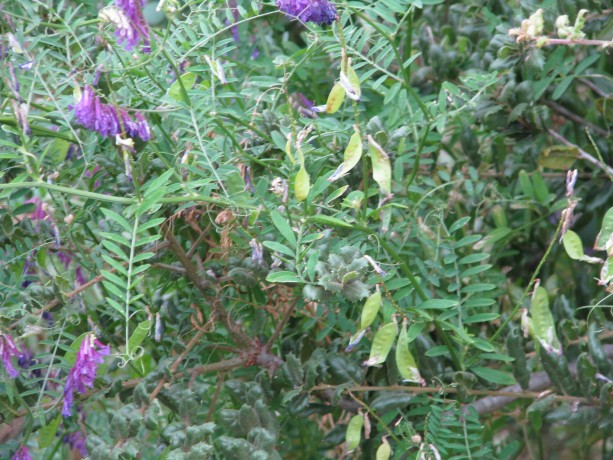
Attractive flowers and seeds. Hairy vetch (Vicia villosa), also known as winter vetch is a nitrogen-fixing plant that is used mostly for cover-cropping in monoculture fields. Native to Europe and Asia, it is a winter plant sown in the Fall and, in places where it snows, is killed off with the cold or tilled into fields. When a nitrogen-fixing plant dies or is cut back, roots die and release the nitrogen nodules into the soil. Here is sunny San Diego the vetch thrived since I sowed it in Spring of last year. It is a pretty, vining plant, with lovely dark purple blooms that bees and other pollinators love. It produces pea pods like its edible relative the fava bean, but I wouldn’t eat them. The seeds may be bad browse for livestock as well. The roots help hold soil during winter rains, too.
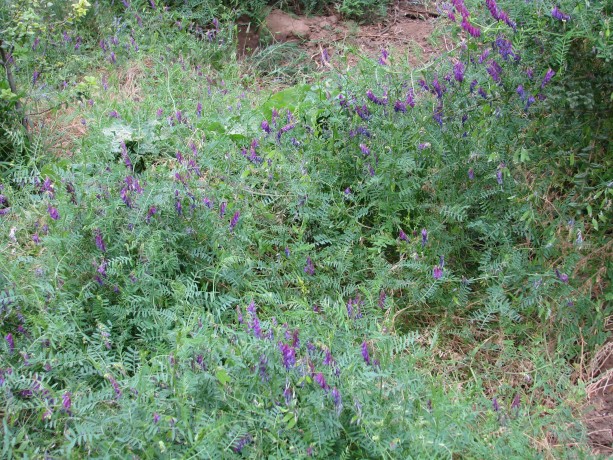
Hairy vetch clamboring all over the place Vetch can be hard to get rid of because it reseeds easily. It will also climb up bushes, competing with the bush for sunlight. If I didn’t know about the nitrogen-fixing properties and if the bees didn’t like it so much, I’d suspect it of being an invasive.
To control it I take my trusty hand scythe and cut the vetch out of bushes and close to the ground. I leave the vines to decompose and protect seedlings that I plant to take advantage of the newly-enriched soil.
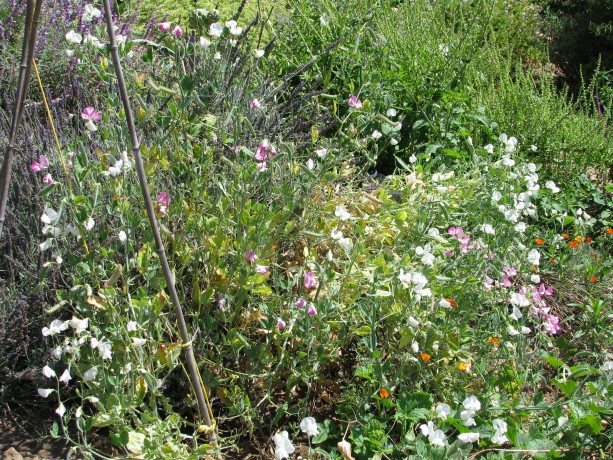
A mass of sweet peas climbing a lavendar. If you don’t want a cover crop that is so aggressive I suggest sowing a mixture of lupine, sweet peas, edible peas and fava beans in the Fall here in Southern California, and again in early Spring. In cold areas check with your farm advisor on when to plant.
-
Fruit Tree Guilds: Making Your Trees Healthy and Happy
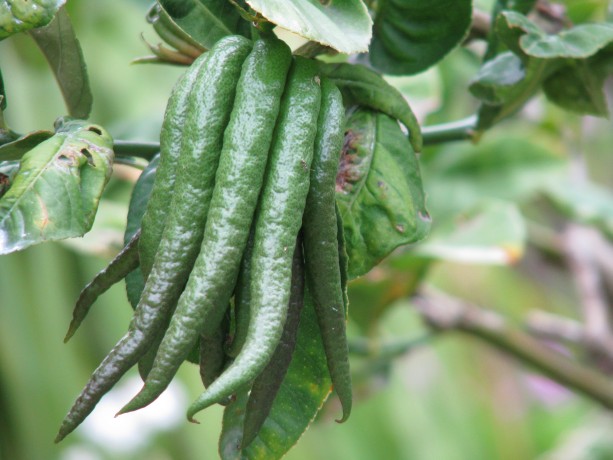
An unripe Buddha’s Hand citron. When bright yellow it freshens a room with a citrusy floral fragrance; is zest is wonderful in cooking and it can be candied. Or simply stuck up a sleeve and used to frighten people. A guild in permaculture terms is, as you know, an arrangement of symbiotic plants that serve as a plant community for the benefit of the whole. Visitors to Finch Frolic Garden often remark that planting guilds sounds so difficult; that they’d need to study so much about plants that it would be impossible for them to do. Not so. However, it isn’t just a whole bunch of plants planted so that they are stepping on each other’s shoes. The typical permaculture plant guild is defined by plants which do these functions: an upper canopy tree (shade, mulch from falling leaves, deep tap roots, roosting for birds which poop, hunt, etc., traps humidity, catches and filters rain and fog moisture), a lower canopy tree (same functions but shorter), a ground cover (habitat for small hunters and moisture trap), a miner plant (deep tap root to bring nutrients from deep in the soil to its leaves which deliver said nutrients when they decompose, and tap root breaks up soil and gives passage for water and worms), a nitrogen-fixing plant (works symbiotically with bacteria to trap nitrogen from the atmosphere on root nodules, which release into the soil when the top dies), and a pollinator-attractor (flowers for bees and all the tiny native bees, wasps and flies).
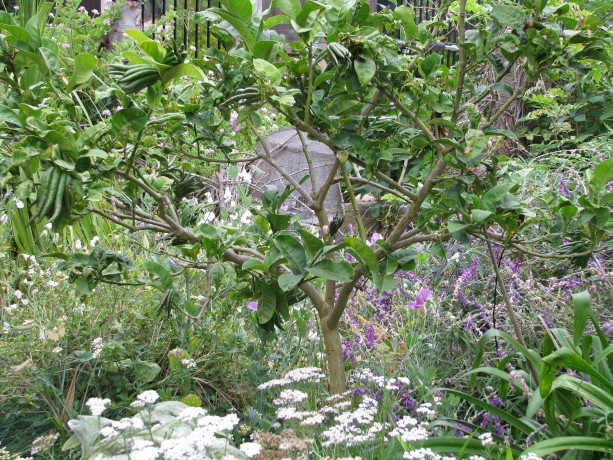
Buddha’s Hand citron (Citrus medica) happy in a guild of yarrow, sweet peas, artichoke (the leaves of which are regularly slashed and dropped), Cleveland sage, scented geranium and a variety of bulbs. The formula isn’t that complicated. I challenge you to come up with an example of each right now. Yes, you can do it. (Dum dee dum… I’m waiting for you to be done before I move on. ) Have it? Okay, here’s a quick example. Mulberry, dwarf peach, strawberries, carrots, sweet peas, dwarf yarrow and fava beans. The canopy trees will lose their leaves allowing sun to warm the understory plants in the winter. Strawberries make an excellent ground cover that grows food and loves the fungus-rich loam made by decomposing leaves. Carrots like cool weather and will thrive until ready to be pulled (and tops broken off and thrown on the ground) about when the trees fully leaf out. Sweet peas attract insects, smell great, and as a bonus are nitrogen fixers, and can twine up the tree trunks. Dwarf yarrow helps choke out grass, is used for many purposes including as a dye plant, and its flowers are clusters of small flowers perfect for the tiny pollinators, and bush peas are completely edible and also fix nitrogen. See? Easy.
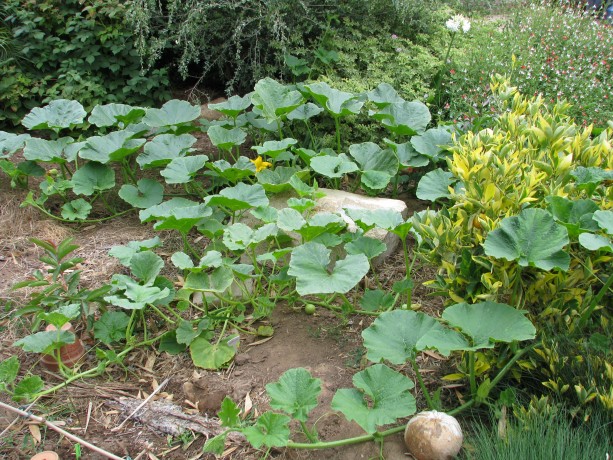
Just in time for summer’s heat, a kabocha squash is rapidly covering the ground around the variegated dwarf orange and a young pink guava. I have to pull squash out of trees because they think they own the world, and it hurts to hit your head on a dangling pumpkin. I leave the vines to decompose in place after harvest. I have many, many trees which were all planted at the same time, and some of them have been neglected. A combination apple tree had been planted in extremely heavy clay and it hasn’t grown much in two years although it keeps trying to produce fruit. Bermuda grass (I cross myself when I mention it) has infiltrated the area to about four inches down. It is helping to break up the clay, but it is also choking out everything else. Plant guild time.

Bermuda grass in heavy clay right next to the trunk: no good. Last weekend I spent about three hours in the morning (mercifully before the June gloom dissipated so I didn’t roast in the heat) digging up and pulling out as much Bermuda grass as I could from the clay. I’d even soaked the area well the night before. That was the stuff of cob ovens. When I’d finally cleared past the tree (I’ll continue another day; there’s only so much of that my hands can take!), I shoveled in some pigeon guano that my good friends up the street deliver to me (tied with a ribbon! Christmas comes all year for a gardener!). The guano is very high in urea… you can smell the ammonia, but it also has feathers, corn and pigeon peas in it. Pigeon peas are a perennial legume that set nitrogen and produce wonderful pea pods for stir-fry. I watered it in well.
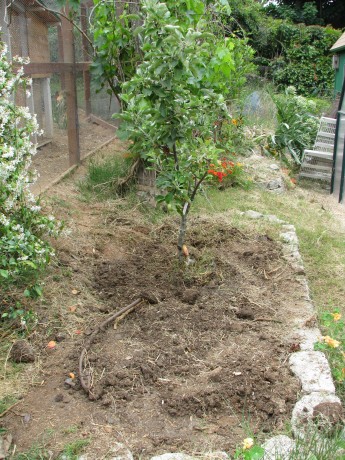
This apple was planted in clay in this planter. Never create a planter around an existing tree; mulch around the trunk will kill it. I had purchased some plants for the area, but to keep costs down just chose some that would fill out and help choke out the angry Bermuda grass bits yearning for revenge. Also, the tree is close by Harry Mud, the cob oven, so I wanted pizza-themed plants for easy picking. I planted strawberries right by the trunk inside the gopher cage in which the tree is planted. They will help retain moisture without compromising the bark of the tree. You never want to pile mulch up around the base of a tree above the root ball because you will rot your tree.
I also planted a tomato, a perennial basil, garlic chives all around the edge (bug protection), sunflowers, a prostrate rosemary and French tarragon. The pigeon peas and corn will very likely sprout. What I didn’t have was an upper canopy, but the tree is on the east side of a shed which protects it from the worst of the summer afternoon sun, and there is a grapevine nearby which produces leaf litter. When daffodil bulbs are readily available in the late Fall I’ll plant a ring of them around the drip line. Gophers don’t eat them, they help keep away the grass, they break up the soil and they are one of my favorite flowers (ranking second to sweet violets). All these plants as they grow up, down and across will help the apple tree, and the apple tree will help them. All of them produce food within easy reach of the cob oven and outdoor dining, are attractive and smell good, too. The tree should flourish. I don’t kid myself that I won’t be pulling Bermuda grass in the future, but the plants will help control it by shading and crowding out.
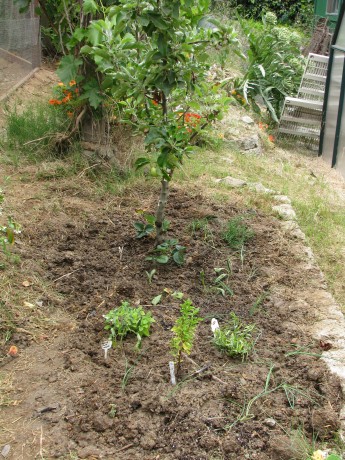
It doesn’t look like much now, but there are eleven support plants/seeds to help the apple tree now. Friends! If you have citrus trees you should plan a little differently. When trying to understand a plant, think of where it came from and in what growing conditions it thrived. Avocados are from South America, with humidity, rainfall, protection from intense heat, deep leaf litter and adequate drainage. Stonefruit are from areas with cold winters; their leaf drop keeps the roots protected from the freezing that triggers the trees to set fruit (chill factor).

This citrus was planted before the bamboo grew up to shade it. Notice how the leaves grow straight up, and none below? It is aiming to collect light at noon, which is the only direct sun that it receives. He needs to be moved. We think of citrus trees perfuming the air of Spain, Greece or Arabia, but actually they come from Southeast Asia and before that, New Guinea and Australia. All of these places have warm or hot temperatures and plenty of sunlight. Although you can plant stonefruit close together, for citrus it is best to ensure that the trees receive lots of direct sunlight or they will drop leaves and have stunted growth.
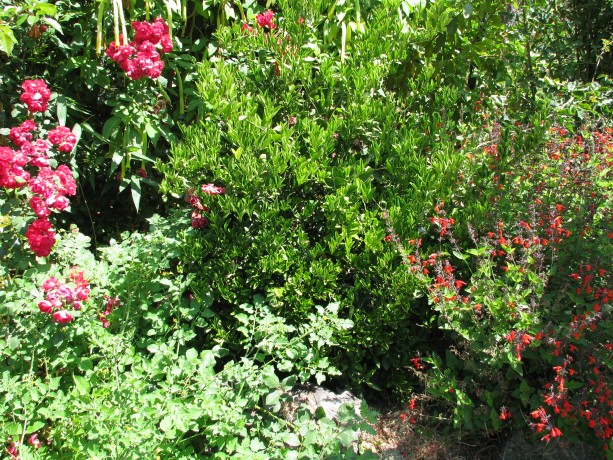
This citrus receives sun all day, and is very happy with the tomato, roses and sage that surround it. Raking all the leaves out from under your trees is so wrong. The tree drops leaves because it needs them on the ground around its roots, not because its careless or its waiting for a human to come by and clean up its mess. Leaf mulch makes the ideal conditions for microbial growth and perfect soil, so let it sit. Augment the mulch by giving your tree company of other plants. Unless the tree is allelopathic (secretes a substance that keeps anything from rooting nearby so that it doesn’t like competition, such as walnuts and eucalyptus) then in nature it reseeds close by and allows other plants to grow under it. Give your trees some appropriate company, and you’ll be rewarded with lots of food, medicine, habitat and very little work except for harvesting. Can’t beat that with a stick.
